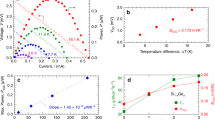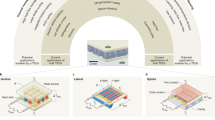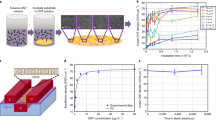Abstract
Microelectronic thermoelectric generators (TEGs), which can recycle waste heat into electrical power, have applications ranging from the on-chip thermal management of integrated circuits to environmental energy sources for Internet-of-things sensors. However, the incompatibility of TEGs with silicon integrated circuit technology has prevented their broad adoption in microelectronics. Here, we report TEGs created using nanostructured silicon thermopiles fabricated on an industrial silicon complementary metal–oxide–semiconductor (CMOS) process line. These TEGs exhibit a high specific power generation capacity (up to 29 μW cm−2 K−2) near room temperature, which is competitive with typical (Bi,Sb)2(Se,Te)3-based TEGs. The high power capacity results from the ability of CMOS processing to fabricate a very high areal density of thermocouples with low packing fraction and to carefully control electrical and thermal impedances. TEG power was also found to increase significantly when thermocouple width was decreased, providing a path to further improvements. Unlike (Bi,Sb)2(Se,Te)3 TEGs, our silicon integrated circuit TEGs could be seamlessly integrated into large-scale silicon CMOS microelectronic circuits at very low marginal cost.
This is a preview of subscription content, access via your institution
Access options
Access Nature and 54 other Nature Portfolio journals
Get Nature+, our best-value online-access subscription
$29.99 / 30 days
cancel any time
Subscribe to this journal
Receive 12 digital issues and online access to articles
$119.00 per year
only $9.92 per issue
Buy this article
- Purchase on Springer Link
- Instant access to full article PDF
Prices may be subject to local taxes which are calculated during checkout




Similar content being viewed by others
References
Bell, L. E. Cooling, heating, generating power and recovering waste heat with thermoelectric systems. Science 321, 1457–1461 (2016).
Kraemer, D. et al. High-performance flat-panel solar thermoelectric generators with high thermal concentration. Nat. Mater. 10, 532–538 (2011).
Chowdhury, I. et al. On-chip cooling by superlattice-based thin-film thermoelectrics. Nat. Nanotechnol. 4, 235–238 (2009).
Li, G. et al. Integrated microthermoelectric coolers with rapid response time and high device reliability. Nat. Electron. 1, 555–561 (2018).
Raihan, A., Siddique, M., Mahmud, S. & Van Heyst, B. A review of the state of the science on wearable thermoelectric power generators (TEGs) and their existing challenges. Renew. Sustain. Energy Rev. 73, 730–744 (2017).
Kim, S. J., We, J. H. & Cho, B. J. A wearable thermoelectric generator fabricated on a glass fabric. Energy Environ. Sci. 7, 1959–1965 (2014).
Vullers, R. J. M. et al. Micropower energy harvesting. Solid State Electron. 53, 684–693 (2009).
Hsu, C. T. et al. Experiments and simulations on low-temperature waste heat harvesting system by thermoelectric power generators. Appl. Energy 88, 1291–1297 (2011).
Rojas, J. P. et al. Review—Micro and nano-engineering enabled new generation of thermoelectric generator devices and applications. ECS J. Solid State Sci. Technol. 6, N3036–N3044 (2017).
Tomita, M. et al. Modeling, simulation, fabrication and characterization of a 10-μW/cm2 class Si-Nanowire thermoelectric generator for IoT applications. IEEE Trans. Elec. Dev. 65, 5180–5188 (2018).
Nolas, G. S., Sharp, J. & Goldsmid, H. J. Thermoelectrics: Basic Principles and New Materials Developments Ch. 1 (Springer, 2001).
Tian, Z., Lee, S. & Chen, G. Comprehensive review of heat transfer in thermoelectric materials and devices. Annu. Rev. Heat. Transf. 17, 425–483 (2014).
Huang, L. et al. Recent progress in half-Heusler thermoelectric materials. Mater. Res. Bull. 76, 107–112 (2016).
Guo, J. et al. Development of skutterudite thermoelectric materials and modules. J. Elec. Mater. 4, 1036–1042 (2012).
Weber, L. & Gmelin, E. Transport properties of silicon. Appl. Phys. A 53, 136–140 (1991).
Hochbaum, A. I. et al. Enhanced thermoelectric performance of rough silicon nanowires. Nature 451, 163–167 (2008).
Boukai, A. I. et al. Silicon nanowires as efficient thermoelectric materials. Nature 451, 168–171 (2008).
Oh, J. H., Shin, M. & Jang, M. G. Phonon thermal conductivity in silicon nanowires: the effects of surface roughness at low temperatures. J. Appl. Phys. 111, 044304 (2012).
Shi, L., Yao, D., Zhang, G. & Li, B. Size dependent thermoelectric properties of silicon nanowires. Appl. Phys. Lett. 95, 063102 (2009).
Zhang, G. et al. Thermoelectric performance of silicon nanowires. Appl. Phys. Lett. 94, 213108 (2009).
Zianni, X. Monte Carlo simulations on the thermoelectric transport properties of width-modulated nanowires. J. Electron. Mater. 45, 1779–1785 (2016).
Curtin, B. M., Fang, E. W. & Bowers, J. E. Highly ordered vertical silicon nanowire array composite thin films for thermoelectric devices. J. Electron. Mater. 41, 887–894 (2012).
Li, Y. et al. Chip-level thermoelectric power generators based on high-density silicon nanowire array prepared with top-down CMOS technology. IEEE Electron Device Lett. 32, 674–676 (2011).
Dávila, D. et al. Monolithically integrated thermoelectric energy harvester based on silicon nanowire arrays for powering micro/nanodevices. Nano Energy 1, 812–819 (2012).
Xu, B., Khouri, W. & Fobelets, K. Two-sided silicon nanowire array/bulk thermoelectric power generator. IEEE Electron Device Lett. 35, 596–598 (2014).
Noyan, I. D. et al. SiGe nanowire arrays based thermoelectric microgenerator. Nano Energy 57, 492–499 (2019).
Noyan, I. D. et al. All-silicon thermoelectric micro/nanogenerator including a heat exchanger for harvesting applications. J. Power Sources 413, 125–133 (2019).
Strasser, M. et al. Micromachined CMOS thermoelectric generators as on-chip power supply. Sens. Actuat. A 114, 362–370 (2004).
Xie, J., Lee, C. & Feng, H. Design, fabrication and characterization of CMOS MEMS-based thermoelectric power generators. J. Microelectromech. Syst. 19, 317–324 (2010).
Yu, X. et al. CMOS MEMS-based thermoelectric generator with an efficient heat dissipation path. J. Micromech. Microeng. 22, 105011 (2012).
Yuan, Z. et al. A planar micro thermoelectric generator with high thermal resistance. Sens. Actuat. A 221, 67–76 (2015).
Min, G. in Thermoelectrics Handbook (ed. Rowe, D. M.) Ch. 11 (CRC Press, 2006).
Glatz, W., Schwyter, E., Durrer, L. & Hierold, C. Bi2Te3-based flexible micro thermoelectric generator with optimized design. J. Microelectromech. Syst. 18, 763–772 (2009).
Edwards, H. et al. in Innovative Materials and Systems for Energy Harvesting Applications (eds Mescia, L., Losito, O. & Prudenzano, F.) Ch. 9 (Engineering Science Reference, 2015).
Santos, J. D. et al. Power response of a planar thermoelectric microgenerator based on silicon nanowires at different convection regimes. Energy Harvest. Syst. 3, 335–342 (2016).
Gustafsson, S., Karawacki, E. & Khan, M. Transient hot-strip method for simultaneously measuring thermal conductivity and thermal diffusivity of solids and fluids. J. Phys. D 12, 1411–1421 (1979).
Acknowledgements
Work at the University of Texas at Dallas (UTD) was supported by the US National Science Foundation under contract no. ECCS-1707581. The fabrication and design of TEG devices was supported by Texas Instruments (TI). The authors thank J. DeBord (TI) for help with copper metal system questions, K. Maggio (TI) for circuit design help, A. Asaadzade (UTD) for assistance with the measurements and M. Kim (UTD) and Q. Wang (UTD) for their aid in taking cross-section SEM images.
Author information
Authors and Affiliations
Contributions
G.H. made measurements, developed and wrote modelling code, and analysed data. H.E. designed the devices, supervised fabrication of the devices and analysed data. M.L. set up measurements, validated data and modelling, and analysed data.
Corresponding author
Ethics declarations
Competing interests
The fabrication and design of all TEG devices used in this work was supported by Texas Instruments. H.E. is an employee of Texas Instruments.
Additional information
Publisher’s note: Springer Nature remains neutral with regard to jurisdictional claims in published maps and institutional affiliations.
Rights and permissions
About this article
Cite this article
Hu, G., Edwards, H. & Lee, M. Silicon integrated circuit thermoelectric generators with a high specific power generation capacity. Nat Electron 2, 300–306 (2019). https://doi.org/10.1038/s41928-019-0271-9
Received:
Accepted:
Published:
Issue Date:
DOI: https://doi.org/10.1038/s41928-019-0271-9
This article is cited by
-
Nature-inspired interfacial engineering for energy harvesting
Nature Reviews Electrical Engineering (2024)
-
Magnetic moment impact on spin-dependent Seebeck coefficient of ferromagnetic thin films
Scientific Reports (2023)
-
Influence of the Mn5Ge3/Ge ohmic-contact interface on the Seebeck coefficient of the Mn5Ge3/Ge bilayer
Scientific Reports (2023)
-
Electrical mapping of thermoelectric power factor in WO3 thin film
Scientific Reports (2022)
-
Micro-thermoelectric devices
Nature Electronics (2022)



